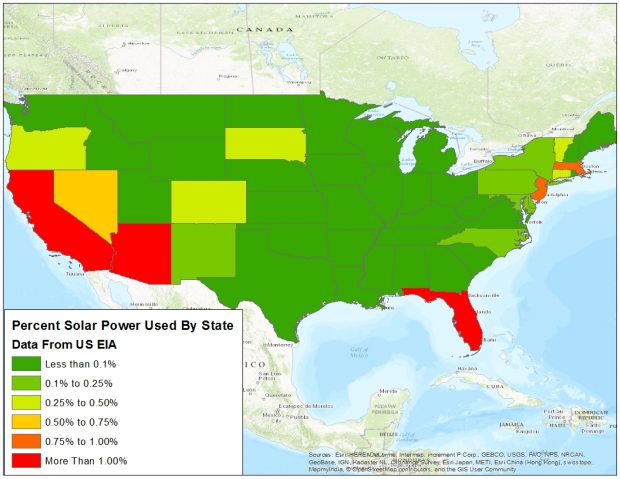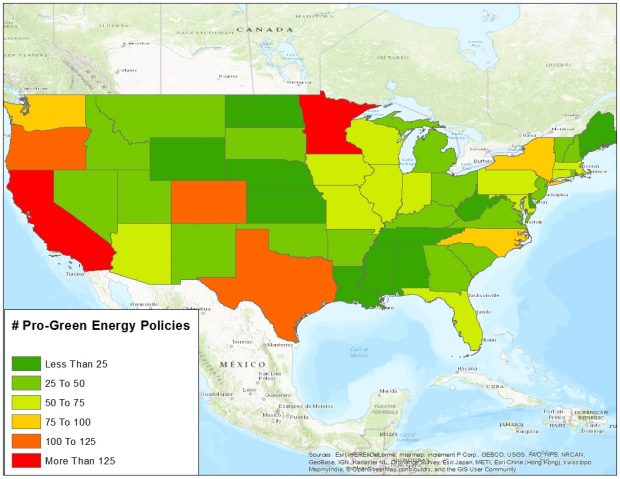America isn’t even close to getting enough energy from wind and solar power to the levels Democrats say are required despite extremely lucrative subsidies, according to an analysis of 2014 data from the U.S. Energy Information Administration (EIA) conducted by The Daily Caller News Foundation.
A draft of the Democratic Party’s proposed platform for this year’s election would require every state get 50 percent of its electricity from “clean sources” by 2020 and 100 percent by 2050. Though the platform never defines what constitutes a “clean” source, wind and solar energy are the only “clean” sources that can significantly expand.
Wind and solar power provided 4.4 and 0.4 of all electricity produced in America in 2014 respectively, according to the EIA. Last year, wind and solar power only accounted for 4.7 and 0.6 percent of all electricity generated in America respectively, according to data from the EIA. Hydropower and biofuels account for six and 1.6 percent of all electricity generated last year, but both are increasingly targeted by the green movement, difficult to rapidly expand and dependent upon regional conditions.
This means that wind power provided substantially more electricity, but grew at a slow rate of less than 6.4 percent, while solar produced far less electricity, but grew at a much faster rate of 50 percent. If both wind and solar power continue growing at their present rates, they will only provide 6.41 and 4.56 percent of America’s electricity by the 2020 deadline.
That’s only one-fifth of the electricity called for by the proposed Democratic platform, even if the extremely high growth rates of wind and solar continue. Even if hydropower, biofuels and geothermal, which are either growing at much slower rates or cannot be expanded, are added in, that would still only account for less than 20 percent of American electricity by 2020. Claiming that America will get 50 percent of its electricity from “clean” power by 2020 is therefore exceedingly unrealistic, even with generous subsidies.
Green energy generation is concentrated in only a handful of states, making the situation much worse. The EIA doesn’t break down wind power use by the state level, but its does for solar in 2014, and the results show that there may be no good way of encouraging solar power to grow more rapidly.

Data From US Energy Information Administration Mapped By The DCNF
Out of the 50 US states, only Hawaii, California, Arizona and Florida got more than 1 percent of energy from solar power. Each one of these states has noticeably favorable weather environments for solar power. Only California had a notably high number of pro-solar power state policies and a majority of US states got less than 0.1 percent of their energy from solar power in 2014.
Statistical regressions run by TheDCNF found no statistically significant correlation between the number of policies and the percentage of solar power obtained by the state. TheDCNF mapped and displayed the data to demonstrate this clear lack of correlation.

Data From Database of State Incentives for Renewables & Efficiency, Mapped By The DCNF
Objectively, Hawaii gets a higher portion of its electricity from solar than any other state, getting 3.66 percent of its energy from solar. However, Hawaii only has 29 policies supporting green energy, which is far fewer than the national average of 51 policies.
Minnesota gets a mere 0.031 percent of its energy from solar, even though it has 141 pro-green energy policies, making it the second most pro-solar regulatory environment in the nation. Other states like Colorado, Oregon, Texas, New York and Washington all had at least 90 pro-green energy policies, but all get less of their electricity from solar than the national average. Alaska, Mississippi, North Dakota, South Dakota and Wyoming got so little energy from solar power that the EIA found that the amount was legally indistinguishable from zero.
A 2014 study by the left-leaning Brookings Institution found wind power is twice as expensive as the conventional power it replaces and that solar is three times as expensive.
Solar power gets 326 times more in subsidies than coal, oil, and natural gas per amount of energy generated, according to 2013 Department of Energy data collected by Forbes.
Solar power by itself receives more federal subsidies than all fossil fuel sources combined, according to the EIA. Green energy in the U.S. got $13 billion in subsidies during 2013, compared to $3.4 billion in subsidies for conventional sources and $1.7 billion for nuclear, according to EIA data. Solar companies simply cannot maintain their current high levels of growth without government support, but even more support likely won’t speed up that growth enough to meet the Democrat’s goals. .
Most solar subsidies go to residential installations and include a 30 percent federal tax credit, while wind is usually industrial scale and is thus somewhat more efficient per dollar spent. Solar-leasing companies install rooftop systems, which cost a minimum of $10,000, at no upfront cost to the consumer. Companies do this because the state and federal subsidies are so massive that such behavior is actually profitable.
TheDCNF previously used statistical analysis to show that the more pro-green energy policies a state has, the less likely it was to reduce carbon dioxide emissions.
Daily Caller intern Josh Delk contributed to this report.
Send tips to andrew@
All content created by the Daily Caller News Foundation, an independent and nonpartisan newswire service, is available without charge to any legitimate news publisher that can provide a large audience. All republished articles must include our logo, our reporter’s byline and their DCNF affiliation. For any questions about our guidelines or partnering with us, please contact licensing@dailycallernewsfoundation.org.


